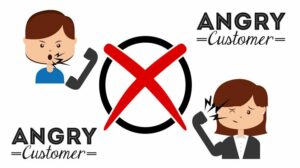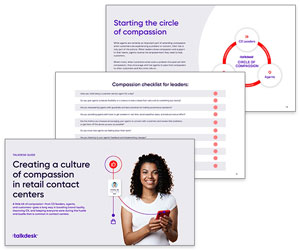Challenging customers are those whose interactions are difficult due to various factors such as high demands, frustration, dissatisfaction, or uncooperative behaviour. While their concerns may be valid, their approach can create tension for employees and businesses.
However, handling difficult customers correctly is essential for maintaining customer loyalty, safeguarding a company’s reputation, and ensuring a positive working environment.
By managing these situations with skill and care, businesses can turn potential conflicts into opportunities for growth and improvement.
To help, we have put together nine common types of challenging customer, and share advice on offering them the best possible customer service.
How to Identify and Manage Different Types of Challenging Customers
1. The Impatient Customer
Impatient customers grow frustrated when you cannot give them the immediate answer that they demand, hinting that they are in a rush to get off the phone.
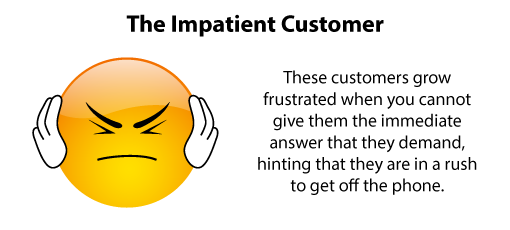
Customer behaviour has changed. We all expect answers and information more quickly now due to the internet and other forms of self-service.
In addition, it is quite common to receive contacts from impatient customers at certain times of the day, as customers call in just before they go to work or just before the contact centre closes, for example.
How to Deal with an Impatient Customer
So you, as an advisor, need to be prepared, and Steve Shellabear, the Managing Director of dancing lion, suggests: “Adjust your pacing and vocal tone so that you are being more direct, which means that you are more likely to develop rapport with them.
Ask if they are short of time and tell them you will do your best to help them quickly. You could also ask if another time would be better to speak and perhaps even arrange an appointment.”
To take this one step further, in complex conversations you could offer to call back once you have gathered all of the necessary information.
If the impatient customer signals that they would rather stay on the phone, you then need to make a conscious effort to signpost what you are doing, so the customer knows why the interaction is taking so long. This will help to stop impatience turning into rudeness.
So, the keys to handling calls from impatient customers include:
- Using a direct style and changing your pacing
- Understanding the query type and deciding whether a callback is required
- Signposting what you are doing
For more on what you can do as the contact centre manager to better serve impatient customers, read our article: How to Design a Contact Centre for Impatient Customers
An Example of an Impatient Customer
A customer calls and urgently demands a quick resolution for a billing inquiry.
They express frustration that they don’t have time to stay on the phone for long, and the agent notices their growing impatience with every passing minute.
The customer might make statements like, “Can you hurry this up?” or “I have another meeting, so just fix it now.”
Despite the agent’s efforts, the customer’s main concern is how fast the issue can be resolved rather than the actual problem.
What to Say to an Impatient Customer
Using this example scenario, here are a few responses an agent could use when talking to an impatient customer:
- “I understand you’re in a rush. I’ll do everything I can to get this sorted quickly for you.”
- “Would it be more convenient if I gather the details now and call you back when I have the full solution?”
- “I’m just looking up the information now so I can give you an accurate answer as soon as possible.”
2. The Angry Customer (With a Legitimate Grievance)
Angry customers with a legitimate grievance have been let down by a process failure within your organization and are angrily taking out their frustrations on you, the unfortunate advisor.
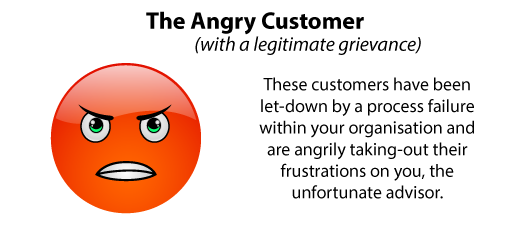
How to Deal with an Angry Customer (With a Legitimate Grievance)
Again, the first step is to listen carefully and acknowledge the customer’s complaint. But then, it’s really important that you thank the customer for bringing this to your attention and for giving the business the opportunity to correct the issue.
Straight after this, you must offer a sincere apology for the inconvenience they have had, while using empathetic phrases to inform them what you are going to do to solve their issue.
After that, you need to check that they are happy with the proposed solution, and Steve says: “It may be appropriate to offer some form of compensation, if you are empowered to do so, but beware of throwing money at a problem. Customers talk to one another and you might have calls from people wanting similar financial compensation down the road.
Just make sure you check that the customer has had their issue addressed and put a note in your diary or system to follow up. This will help you to make sure that the customer is satisfied.
Remember that when a customer has their complaint resolved well, they are likely to do business with you again and again and tell others how well you dealt with the situation.”
This final point is especially true in today’s world, with the power of social media, while it is also far cheaper to market services and products to an existing customer than look for new prospects!
So, the keys to handling calls from angry customers (with a legitimate grievance) include:
- Listening carefully and acknowledging the issue
- Offering a sincere apology and showing empathy
- Checking they are happy with your solution and following up
For more on offering service to this customer type, read our article: Dealing With Angry Customers
An Example of an Angry Customer (With a Legitimate Grievance)
A customer calls after receiving a defective product, and they’re angry because it was meant as a gift for a special occasion.
They feel let down and express their frustration in an upset tone, saying things like, “This is unacceptable. You’ve ruined a very important day for me.”
They demand immediate action and compensation for the inconvenience caused, emphasizing how they’ve been wronged by the company’s process.
What to Say to an Angry Customer (With a Legitimate Grievance)
Using this example scenario, here are a few responses an agent could use when talking to an angry customer with a legitimate grievance:
- “I’m really sorry that this happened and completely understand your frustration. Thank you for bringing this to our attention so we can make it right.”
- “I’m going to make sure we get this sorted for you as quickly as possible. Here’s what I’ll do to resolve the issue…”
- “Would a replacement or refund work best for you in this case? I want to make sure we correct this to your satisfaction.”
3. The Offloading Customer
Offloading customers are also angry, but their grievance isn’t so legitimate. They may be in a bad mood when they call in with a routine query and just be looking to offload their problems.
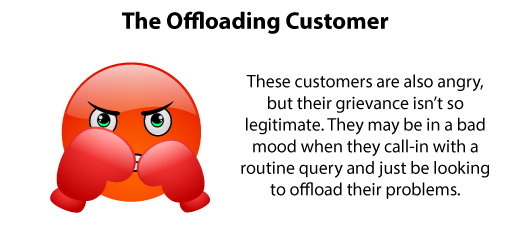
How to Deal with an Offloading Customer
This is a difficult customer type to deal with because, when the conversation starts, it can often sound as if the issue may be legitimate.
So, patience is the name of the game here, giving the customer that free space to vent. As time goes on, it will become easier for you to tell if they’re just unloading other issues.
Just remember, everyone has things that upset them, whether that might be things going on in their personal life or whatever, so you – as the advisor – need to understand this and actively manage your own emotions.
As Steve says: “You need to be conscious of your own emotional reactions and ensure that your vocal tone doesn’t convey irritation but remains professional and polite.
Then, you again just need to thank the customer for bringing the matter to your attention, acknowledging their situation and moving the conversation on. You could maybe do this while helping them further by signposting others who can assist them.”
While we hope most calls with an “offloader” go this smoothly, this will not always be the case. So make sure your advisors are fully supported by an abusive customer policy.
So, the keys to handling calls from offloading customers (without a legitimate grievance) include:
- Controlling your emotions and tone of voice
- Acknowledging how the customer feels
- Identifying the customer’s core needs
For more on offering service to this customer type, read our article: Dealing With Angry Customers
An Example of an Offloading Customer
A customer calls about a minor issue, such as a simple password reset, but soon starts expressing frustration about unrelated matters—complaining about their day or other companies they’ve dealt with.
They might say things like, “And this is just the latest in a string of bad customer service experiences I’ve had today!”
The customer is more focused on venting their emotions than the issue at hand, and the agent must navigate the conversation back to resolving the technical query.
What to Say to an Offloading Customer
Using this example scenario, here are a few responses an agent could use when talking to an offloading customer:
- “I hear that you’ve had a tough day, and I appreciate you sharing that. Let’s focus on getting this resolved for you quickly.”
- “I understand things can be frustrating sometimes. Let me take care of your request so you can move forward.”
- “It sounds like there’s been a lot on your plate today. Let’s get this sorted for you so you can have one less thing to worry about.”
4. The Talkative Customer
Talkative customers are generally very friendly, but they won’t stop talking and can, if not carefully managed, keep you on the phone for a lot longer than you want to be.
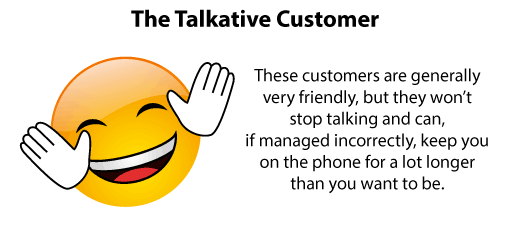
How to Deal with a Talkative Customer
When you first start to interact with a talkative customer, you need to use active listening and acknowledge them whenever they express an emotion. This is because they often won’t stop talking as they believe that no one is listening to them.
However, if this is not the case, you need to take greater control of the call, asking closed questions to minimize their response and using techniques such as signposting.
Steve adds: “In extreme cases, when the customer talks over you, simply stop giving the verbal nods or minimal encouragers (uh-huh, yes, etc.) that we are socially conditioned to deliver.
The customer is likely to notice the expected responses are not there and say, ‘Are you still there/listening?’ At which time you can acknowledge and lead the conversation.”
Steve’s point revolves around the idea that you can change the customer’s behaviour by doing something that’s unexpected. This would no doubt disrupt the talkative customer’s flow and allow you to take control of the situation. The key is to ensure that you do this politely.
So, the keys to handling calls from talkative customers include:
- Using active listening
- Offering acknowledgement
- Breaking social conditioning (in extreme cases)
If you are looking for ways to train active listening in your agents, read our article: How to Train Active Listening in the Call Centre – With Exercises
An Example of a Talkative Customer
A customer calls with a simple query about their account balance but quickly drifts into telling long stories about their family or recent vacation.
The call, which should have been resolved in a couple of minutes, is now dragging on because the customer continues to share unrelated details.
What to Say to a Talkative Customer
Using this example scenario, here are a few responses an agent could use when talking to an talkative customer:
- “That sounds like a lovely trip! Let’s get back to your account, and I’ll make sure everything is in order for you.”
- “I appreciate you sharing that with me. Just to confirm, you wanted to check your balance, right?”
- “It’s great to hear you’ve been having a good time! Now, regarding your account, let’s see what we can do to help you today.”
5. The Indecisive Customer
Indecisive customers just cannot make a decision, so they either ask lots of questions or instead keep switching between different options.
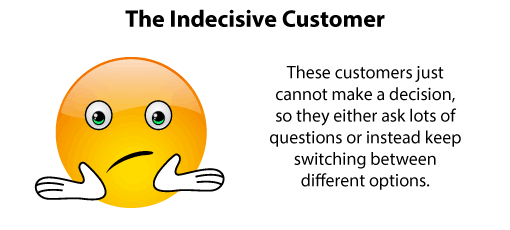
How to Deal with an Indecisive Customer
With indecisive customers, you need to stayed focused on the end goal. To get there, you need to consider whether or not you know the customer’s decision-making criteria.
If you are unsure, take control of the situation and ask them: “what is it you are looking for?” “What things (features) are important to you?”
Steve says: “With these answers, you can match their requirements with what your company can offer and you can reiterate the key benefits for the customer.
Also, they may be worried about making the wrong decision, so think about how you can reduce the risk for them. Can you offer a trial period where they can return the goods?”
If advisors are empowered to offer things like trial periods, this can be a really useful tool. But your approach will likely come down to why you think the customer is delaying making their decision.
The customer’s delay reasons could be anything from not having the time to evaluate all of their options fully to there being too much pressure on the decision, so they have that “fear factor”.
If you can decipher what the delay reason is, your chances of handling the call successfully will greatly increase.
So, the keys to handling calls from indecisive customers include:
- Effective call questioning
- Problem-solving
- Advisor empowerment
If you are looking for types of questioning, or questioning techniques, you can use in customer service, read our article: 6 Effective Questioning Techniques for Customer Service
An Example of an Indecisive Customer
A customer is trying to decide between two service packages and cannot make up their mind. They keep asking about the pros and cons of each option, worrying about making the wrong decision.
They ask the agent multiple questions, switching between options, and hesitate to commit. They might say things like, “I’m just not sure… what if this isn’t the right choice for me?”
What to Say to an Indecisive Customer
Using this example scenario, here are a few responses an agent could use when talking to an indecisive customer:
- “It sounds like both options have some appeal. Let’s focus on what’s most important to you so I can help you make the best decision.”
- “Would it help if I explained how each option fits your needs? I want to make sure you’re confident in your choice.”
- “If you’re concerned about making the wrong decision, some customers like to start with a trial period. Would that help ease your decision?”
6. The Know-It-All Customer
Know-it-all customers have done their research and will challenge the advice that you give them, using an internet search or a friend’s experience to tell you that you’re wrong.
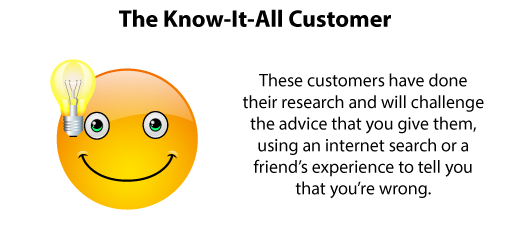
How to Deal with a Know-It-All Customer
The dilemma here is that you don’t want to alienate the customer by proving them wrong, nor should you be passive and submissive just because they are the customer.
So, acknowledge they’ve done their research and have taken the time to ensure they are informed, while keeping calm by reminding yourself that they value what you have to offer. If they didn’t, they wouldn’t be speaking to you.
The next step is to respond assertively, sharing your knowledge and expertise, linking back to what the customer has previously told you, especially when it comes to their main requirements.
This is according to Steve, who says: “Remember you do this for a living. You know the market inside and out. Let them know they are getting ‘inside information’ based on your experience.
If they go ‘macho’ on you, use phrases like ‘as you probably know’ and ‘as you may have found’, so they don’t feel the need to assert their superiority or have you recognize their knowledge.”
Steve’s last point is key, as it is easy to react to negative tones of voice. Stay calm and professional, and as the call goes on, the customer will likely begin to recognize your superior knowledge for themselves.
So, the keys to handling calls from know-it-all customers include:
- Acknowledging their research
- Responding assertively
- Staying calm and professional
An Example of a Know-It-All Customer
A customer has done extensive research online about a product and calls to challenge the agent’s advice, citing information they found on various websites.
They might make comments like, “Well, according to what I read, that’s not how it works,” or “I know all about this already.”
This customer believes they have more knowledge than the agent and questions everything the agent says, requiring the agent to balance acknowledging their research while still providing expert guidance.
What to Say to a Know-It-All Customer
Using this example scenario, here are a few responses an agent could use when talking to an know-it-all customer:
- “It sounds like you’ve done a lot of research on this, which is great! Based on what you’ve found, let me add some additional insights from our side.”
- “As you probably know, the market has a lot of information. Let me share what we’ve learned from helping other customers with this same issue.”
- “I appreciate that you’ve looked into this already. Let’s combine what you’ve learned with the inside knowledge we have here to get the best outcome for you.”
7. The Confusing Customer
Confusing customers keep asking questions that are unrelated to their issue, perhaps making irrelevant points as well, potentially indicating that they are vulnerable.
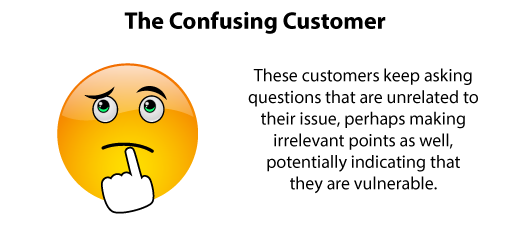
How to Deal with a Confusing Customer
To handle these customers, advisors need to be coached on how to identify individuals who could be vulnerable customers and, when a customer shows these traits, they need to know how to handle the situation effectively.
If someone is asking unrelated questions, you will naturally be questioning their grasp of what was being said. But you mustn’t be fazed by this. Instead, listen politely and acknowledge their questions at a factual level.
This is according to Steve, who says: “Depending on your organization’s policy, advisors need to know when they can offer specialist help, and it is up to management to develop and coach methods of handling vulnerable customers.
The basics of some of these methods include clarifying the customer’s understanding after each point, speaking at a relaxed pace and avoiding assumptions.”
An experienced advisor may also be careful to use closed questions to close the conversation down, as opposed to opening the conversation up and overwhelming the customer. You just need to make sure customers are sure of what they are saying yes and no to.
So, the keys to handling calls from confusing customers include:
- Identifying vulnerable customer traits
- Using basic techniques like clarifying understanding after each point
- Asking closed questions carefully
For more on handling this customer type, read our article: Dealing With Vulnerable Customers
An Example of a Confusing Customer
A customer calls with a question but keeps jumping from one topic to another, asking unrelated or confusing questions.
They might be overwhelmed or unsure of what they really need, making it difficult for the agent to pin down the core issue.
For example, the customer might ask about billing but then start discussing unrelated product features, leaving the agent to guide them back to the original question.
What to Say to a Confusing Customer
Using this example scenario, here are a few responses an agent could use when talking to an confusing customer:
- “Let me clarify what you’re asking so I can make sure we’re solving the right issue. Are we focusing on your billing concern first?”
- “It’s important that we address your main question. Let’s take it one step at a time, starting with what’s most pressing for you.”
- “I want to make sure we don’t miss anything. Let’s go over your questions one by one so we cover everything you need.”
8. The Demanding Customer
Demanding customers have unrealistic expectations and demand something that you simply cannot deliver, leaving you in an awkward “stand-off” position.
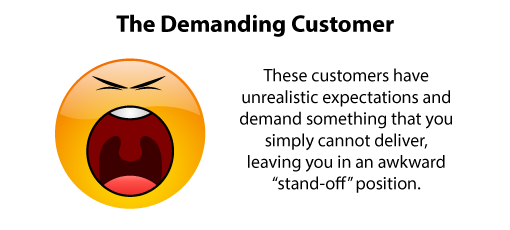
How to Deal with a Demanding Customer
Again, the first step in handling this call is acknowledgement. And not just acknowledging what they want, but why they want it, in order to build a certain level of rapport.
Then, you need to be truthful and say what you can’t do, but you should also let them know what you can do for them and frame that in the best possible light.
So, emphasize the positives by using positive words to put forward the realistic option, using words like ‘great’ and ‘fantastic’ to inject energy into the conversation.
Steve adds: “When the customer demands something that isn’t realistic, what you need to be able to say is: ‘I can’t do that for you, but what I can do for you is…’.
This means that you leave the customer with something positive and that they have control over, so they are confident that something will and can be done after that call.”
If the customer still isn’t best pleased, highlight where else they may be able to obtain what they are looking for.
But if they continue to still ask for the unrealistic option, spell out why you cannot deliver that, don’t just say, “It’s company policy.” Customers hate that!
So, the keys to handling calls from demanding customers include:
- Acknowledging what they want and why they want it
- Using positive words to frame your preferred option
- Highlighting where else they may be able to obtain what they’re looking for
If you are looking for some positive spiel to help brighten up your customer conversations, read our article: The Top 25 Positive Words and Phrases for Customer Service
An Example of a Demanding Customer
A customer calls with expectations that exceed what the company can realistically provide. For example, they might demand free next-day shipping on an item that isn’t eligible or ask for a discount that isn’t available.
They may insist on something outside of company policy, saying things like, “I don’t care about your rules—I want this done now.”
The challenge for the agent is explaining the limitations while still offering an alternative solution.
What to Say to a Demanding Customer
Using this example scenario, here are a few responses an agent could use when talking to an demanding customer:
- “I understand why that would be ideal for you. While I can’t offer free next-day shipping, what I can do is expedite it for a reduced fee.”
- “I’m really sorry, but that’s not something we can provide. However, I can offer this alternative, which might work just as well for you.”
- “While we can’t do that exactly, let me highlight another great option that’s available to you right now.”
9. The Nit-Picking Customer
Nit-picking customers will never be satisfied, no matter what you do. Instead, they question your decision-making at every opportunity and adopt a passive-aggressive tone.
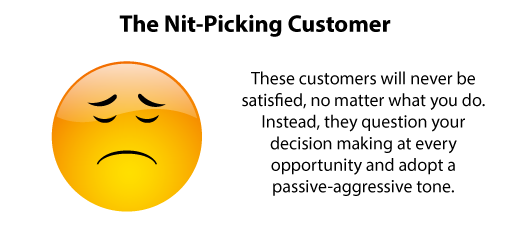
How to Deal with a Nit-Picking Customer
As the advisor, your patience is really going to be tested here. After all, some people just cannot be satisfied. If these customers won the lottery, they would complain that the notes weren’t new enough.
So, you need to again be conscious of your own emotions when taking these calls, ensuring that you are being patient, polite and maintaining a respectful tone of voice.
In terms of controlling the direction of the call, Steve says: “Point out the benefits of what your company is offering and ask if that will help them. The key is to try and find out what they want.
There are a variety of different reasons why some people nit-pick – it can be chronic, habitual or emotive. If you think it’s emotive, you can potentially turn that customer around by being human, not reacting to the negatives and showing empathy.”
Although it’s difficult, your role as an advisor is to be professional and friendly and to see if you can win the customer over.
Just remember to think the best of the customer and consider that they may be upset about something else, so there may still be an opportunity to win them around.
So, the keys to handling calls from nit-picking customers include:
- Being patient and maintaining a respectful tone of voice
- Promoting the benefits of your product actively
- Identifying their key “call drivers”
For advice on the importance of tone of voice in customer conversations, read our article: How to Utilize Tone of Voice in the Contact Centre
An Example of a Nit-Picking Customer
A customer keeps calling to raise minor complaints, seemingly never satisfied with the solutions offered.
They might question every detail, pointing out small issues like a slight delay in response times or minor discrepancies in a product description.
Even after a resolution, they continue to find flaws, saying things like, “Well, that’s not quite right either.”
The challenge for the agent is maintaining patience while trying to meet the customer’s expectations.
What to Say to a Nit-Picking Customer
Using this example scenario, here are a few responses an agent could use when talking to an nit-picking customer:
- “I can see that you’re very detail-oriented, and I want to make sure we meet your expectations. Let’s go over what we’ve done so far to make sure it’s all correct.”
- “I understand that every little detail is important to you. Let me assure you that we’re working to get this perfect for you.”
- “It sounds like you’re still not completely happy. Let’s review what’s left to improve so we can get everything just right.”
The Common Themes
Handling calls from challenging customers is where advisors really earn their money. From the list of nine types of challenging customers above, we have noticed some common themes in handling different challenging customer types.
So, before this article comes to a close, we just want to highlight some of the common tools for handling challenging customers, which, if used properly, will lead to many more successful contact centre conversations.
- Using active listening to get all the necessary information
- Acknowledging how the customer feels and showing empathy
- Managing your own emotions and tone of voice
- Adopting different questioning techniques where appropriate
- Identifying the customer’s main “call drivers”
We hope that your team is confident in each of these areas. But if not, a quick search of the Call Centre Helper website should give you plenty of hints and tips to help you on the way.
For more on handling challenging customers, read our articles:
- “I’d Like to Speak to a Manager” – 7 Ways to Deal With Difficult Customers
- How to Deal With Rude Customers
- How to Deal With a Customer Who Can’t Stop Talking
Author: Charlie Mitchell
Reviewed by: Robyn Coppell
Published On: 21st Nov 2022 - Last modified: 20th Sep 2024
Read more about - Skills, Angry Customers, Call Handling, Charlie Mitchell, Customer Management, Editor's Picks, Empathy, Handling Customers, Soft Skills, Steve Shellabear







